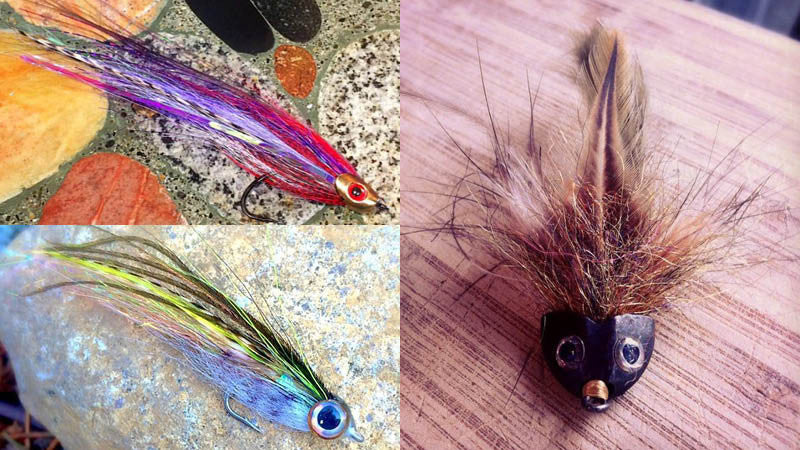Fly Tying: Why Is My Baitfish Pattern Swimming Wrong?


You sat up late last night tying the perfect baitfish pattern in hopes of finally hooking the elusive beast that's been refusing all your fly patterns to date.
You tie your fly on, throw your first cast, and strip, strip...
“What the ^*%}?!”
Your fly is swimming like a belly up version of the goldfish you won at the fair in 5th grade.
What went wrong?
Below you can learn about a few of my findings over the years along with video demonstrations in the Fly Tester. Using the Fly Tester helps me observe the swimming action of my flies immediately after tying and improve them so I have confidence they will perform as intended.
Here are the top 3 reasons why your baitfish pattern is swimming wrong.
Problem 1: Too Much "Fluff"

Try eating Thanksgiving dinner and then attempting to sprint down the block.
You'd likely resemble Chris Farley doing his "van down by the river" walk.
Similar to that is your fly. When there's too much "fluff" and materials, the fly won't keel correctly. The result is a side-to-side flip, because there's no specific portion of the fly weighing it down.
It's an all-around over-fluffy fly.
The Solution

Don't use too much material!
Think, "Does it really need that extra bucktail?" Or, "Is it truly necessary for it to have that Guinea collar?"
I like to question my material selection at every step this way.
If you find the head is the epicenter of the material excess, try eliminating the dubbed, deer hair, or ram's wool head and use a Fish-Mask or Baitfish Head instead to create a uniform fish face without all the bulk. In addition, the Baitfish Head will weigh it down and keep even the fluffiest fly swimming correctly.
Lastly, if your pattern calls for dumbbell eyes or lead to swim with the hook point up and it's still riding sideways, it means there's not enough weight to counterweight it.
I always tie two flies and test them both in my Fly Tester before continuing. That way I don't invest a ton of time on flies that turn out to be useless.
Problem 2: Hook Weight

Guiding in saltwater, I learned my lesson on being cheap with hooks.
I tie a few identical patterns of each baitfish prior to each trip, and after one night with an excessive bar tab I thought I'd skimp on the quality of the hooks for my trip.
My client cast the first fly out and it started doing the same side swaying swim as the too fluffy fly, but the pattern adhered to every tip-in, staying sleek and streamlined.
So if it wasn't too fluffy, what the heck was wrong now?!
The Solution

Don't be cheap on hooks!
If you're tying saltwater flies don't go for the cheap plated stainless hooks. I'll only buy solid stainless hooks for saltwater now. And as a bonus, they won't rust on you when you forget to dry out your fly box!
Always match the pattern with the hook!
Don't buy the hooks first and think of the pattern later. You wouldn't assume you could gain 40 pounds and run the mile in the same speed, right?
Same goes for flies. Don't expect both a deceiver and a floating gurgler tied on the same hook to both ride correctly. The deceiver requires a much heavier hook than the gurgler.
Problem 3: Flapping Fins

You go to change out flies and notice your leader is kinked like a corkscrew in the inch or two up to the fly.
Throwing it in the water and swimming the fly in front of you reveals the fly is spinning with each retrieve.
The Solution

The fins are either uneven or too stiff.
I love me a good looking sculpin pattern – realistic in appearance with pectoral fins as opposed to just a fluffy collar.
But for all the feathers in the fly shop, there are only a few that are durable enough to withstand abuse yet soft enough to not force a fly to spin. I prefer to use India hen back feathers, as they typically have a natural round shape and are the perfect sculpin pectoral fin size.
If you choose to use deer hair and use figure-eight clumps of it on top of the hook shank to form two separate fins, make sure not to use too much hair. This will most definitely cause it to spin both while casting and retrieving.
Using too much deer hair for the fins will place your fly in a few of the categories I've listed and will result in one funky-swimming sculpin.
If you're like me and want a quick fix, just add a Sculpin Helmet and it will do all the math for you and immediately correct the fly!
These are just a few of the main causes I've found for why my baitfish isn't swimming right.
Still Swimming Funky?
If I find I've tried every correction I've listed above and my fly is still swimming funky, it means it's time to either grab a coffee or a beer and forget that fly for an hour or two, because sometimes it's the angler, not the fly!
Fly Tying: Why Is My Baitfish Pattern Swimming Wrong? Part 2
Learn More About the Fly Tester
Tie → Test → Fish
Take your fly tying to the next level with the complete out of the box solution for fly testing and demonstration. The Fly Tester creates a steady circular flow of water with adjustable flow control, allowing you swim up to 3 flies in 2 directions at once – from streamer flies, to top water flies, to nymphs and emergers.
Want More Content Like This?
Join the Flymen Mailing List at the Bottom Right of the Page!
About Brita Fordice:
 Growing up on the Stillaguamish River in Washington state, Brita learned to fly fish at the age of 8, and taught herself to tie flies at 10. After living in both Alaska and Idaho for a few years, she moved back to Seattle in 2004 and has been an employee and guide with Avid Angler Fly Fishing Outfitters since. Her passion lies in guiding Puget Sound beaches and hunting cutthroat and salmon off the sand with baitfish patterns she's created. Follow her on Instagram: @seafly907. If you're interested in booking a guided trip, email her at: britaf@avidangler.com.
Growing up on the Stillaguamish River in Washington state, Brita learned to fly fish at the age of 8, and taught herself to tie flies at 10. After living in both Alaska and Idaho for a few years, she moved back to Seattle in 2004 and has been an employee and guide with Avid Angler Fly Fishing Outfitters since. Her passion lies in guiding Puget Sound beaches and hunting cutthroat and salmon off the sand with baitfish patterns she's created. Follow her on Instagram: @seafly907. If you're interested in booking a guided trip, email her at: britaf@avidangler.com.



Flyman news letter please
Thank you Louis alonzi
Found your site thru Fly Tyer Mag. You have some great stuff. I am a flat lander and am trying to learn the art of fly fishing and tying. your site is a great resource.
Muchas gracias. ?Como puedo iniciar sesion?
subscribe to the newsletter. thx
Please add me to your mailing list.
Leave a comment